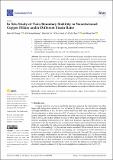In Situ Study of Twin Boundary Stability in Nanotwinned Copper Pillars under Different Strain Rates
Author(s)
Chang, Shou-Yi; Huang, Yi-Chung; Lin, Shao-Yi; Lu, Chia-Ling; Chen, Chih; Dao, Ming; ... Show more Show less
Downloadnanomaterials-13-00190.pdf (5.300Mb)
Publisher with Creative Commons License
Publisher with Creative Commons License
Creative Commons Attribution
Terms of use
Metadata
Show full item recordAbstract
The nanoscopic deformation of ⟨111⟩ nanotwinned copper nanopillars under strain rates between 10<sup>−5</sup>/s and 5 × 10<sup>−4</sup>/s was studied by using in situ transmission electron microscopy. The correlation among dislocation activity, twin boundary instability due to incoherent twin boundary migration and corresponding mechanical responses was investigated. Dislocations piled up in the nanotwinned copper, giving rise to significant hardening at relatively high strain rates of 3–5 × 10<sup>−4</sup>/s. Lower strain rates resulted in detwinning and reduced hardening, while corresponding deformation mechanisms are proposed based on experimental results. At low/ultralow strain rates below 6 × 10<sup>−5</sup>/s, dislocation activity almost ceased operating, but the migration of twin boundaries via the 1/4 ⟨<inline-formula><math xmlns="http://www.w3.org/1998/Math/MathML" display="inline"><semantics><mrow><mn>10</mn><mover accent="true"><mn>1</mn><mo>¯</mo></mover></mrow></semantics></math></inline-formula> ⟩ kink-like motion of atoms is suggested as the detwinning mechanism. At medium strain rates of 1–2 × 10<sup>−4</sup>/s, detwinning was decelerated likely due to the interfered kink-like motion of atoms by activated partial dislocations, while dislocation climb may alternatively dominate detwinning. These results indicate that, even for the same nanoscale twin boundary spacing, different nanomechanical deformation mechanisms can operate at different strain rates.
Date issued
2023-01-01Department
Massachusetts Institute of Technology. Department of Materials Science and EngineeringPublisher
Multidisciplinary Digital Publishing Institute
Citation
Nanomaterials 13 (1): 190 (2023)
Version: Final published version